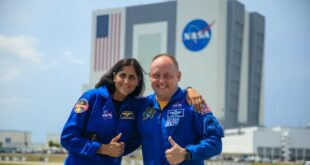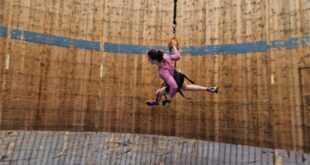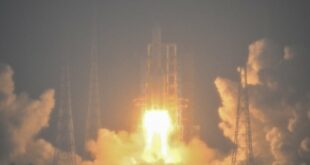Montreal composer drew on same data used to create vibrant images of the cosmos

Music can often transport you to another time and place. But now a Montreal composer is bringing listeners far out into the cosmos with a piece of music created from NASA's data on the Milky Way.
"At the end of the piece, especially … I'm focusing in on the black hole that's at the centre of the galaxy. And you get this feeling of stars spiralling toward the centre," said Sophie Kastner, composer of Where Parallel Lines Converge.
"I wanted to have all of these pingy, like, high textures that are just, like, continuously spiralling," she told The Current's Matt Galloway.
Kastner's piece isn't just an artist's impression. Her music was generated from the type of data NASA scientists usually use to create stunning visual images of deep space. In fact, the same data was used to create an image of the centre of the Milky Way, which Kastner also used for inspiration.
The finished piece uses data from the Hubble, Chandra and Spitzer telescopes, in a composition played on up to seven instruments. She chose a glockenspiel and violin to convey that movement and sense of spiralling for the black hole; and lower, rougher timbre instruments like the bass clarinet and cello to capture that sense of mystery that comes with gazing into space.
Kastner worked with scientist Kimberly Arcand, an expert in creating those visualizations.
"We're just taking the image and mathematically mapping it, taking those pixels and translating them into something you can hear instead," said Arcand, a visualization scientist at NASA's Chandra X-ray Observatory and the Smithsonian Astrophysical Observatory.
Arcand explained that the data from deep-space telescopes starts out as 1s and 0s before being analyzed and compiled into tables of information. Those details include things like the amount of energy, or locations of photons — particles of light — hitting the telescope, she said.
NASA has experimented with creating simple audio representations before, with a data sonification project called the Universe of Sound. Kastner was originally asked to turn those soundscapes into sheet music, so they'd be easily available for musicians.
"I slowly realized there was so much more of a story to tell with the image … and that there was really a composition there … there was a whole piece of music," she said.
For Arcand, getting to hear data translated into a sophisticated piece of music was something new.
"I almost fell out of my chair, it was so beautiful," she said.
"It makes me think of the data differently; it makes me process it differently and I really appreciate that."
Making meaning from a chaotic cosmos
Arcand said the idea of turning raw data into sound initially came from her colleague Wanda Diaz, an astronomer who developed the novel approach after she lost her sight early in her career.
That idea grew into the Universe of Sound, a project to make understanding space more accessible, while also creating beautiful starscapes of sound.
One of the results is Galactic Center Sonification, a short soundscape based on the same image of the centre of the Milky Way that Kastner worked with.
"[What you can hear is] a beautiful sort of sweep across an image of the inner, say, 400 light years of our Milky Way," Arcand said.
"It's kind of like the downtown region, where there's black holes and little explosions and lots of stars. And you're hearing us translate those pixels into sound."
For Arcand, it was important that the musical choices made sense with the scientific facts of the image — particularly for such a busy part of our galaxy.
"It's like Times Square. There's all of this stuff happening. It's so energetic," she said.
"In order for our human brains to make meaning from these sounds, we need to make sure that it's both distinct enough in sound, but also that they combine well together," she said.

Kastner said the project made her realize her work as an artist isn't so far away from the field of science.
"As humans, we're always trying to make sense of the world, and one of the ways we make sense of the world is through art," she said.
"So why shouldn't science and art be connected?"

Add some “good” to your morning and evening.
A variety of newsletters you'll love, delivered straight to you.
*****
Credit belongs to : www.cbc.ca
 MaharlikaNews | Canada Leading Online Filipino Newspaper Portal The No. 1 most engaged information website for Filipino – Canadian in Canada. MaharlikaNews.com received almost a quarter a million visitors in 2020.
MaharlikaNews | Canada Leading Online Filipino Newspaper Portal The No. 1 most engaged information website for Filipino – Canadian in Canada. MaharlikaNews.com received almost a quarter a million visitors in 2020.







